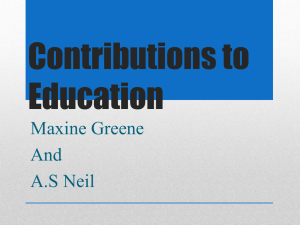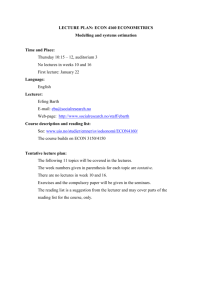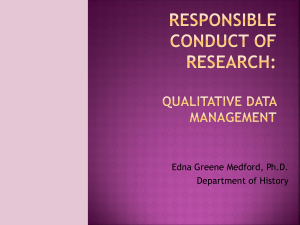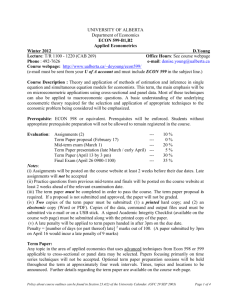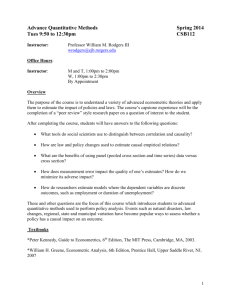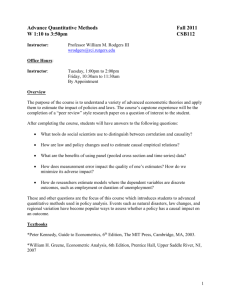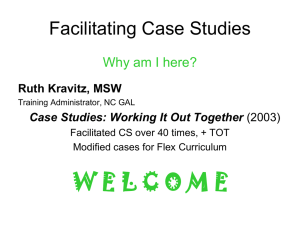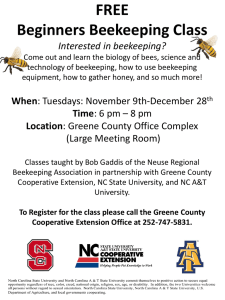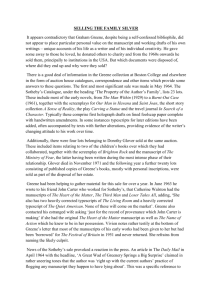ARTE 710 September 14
advertisement
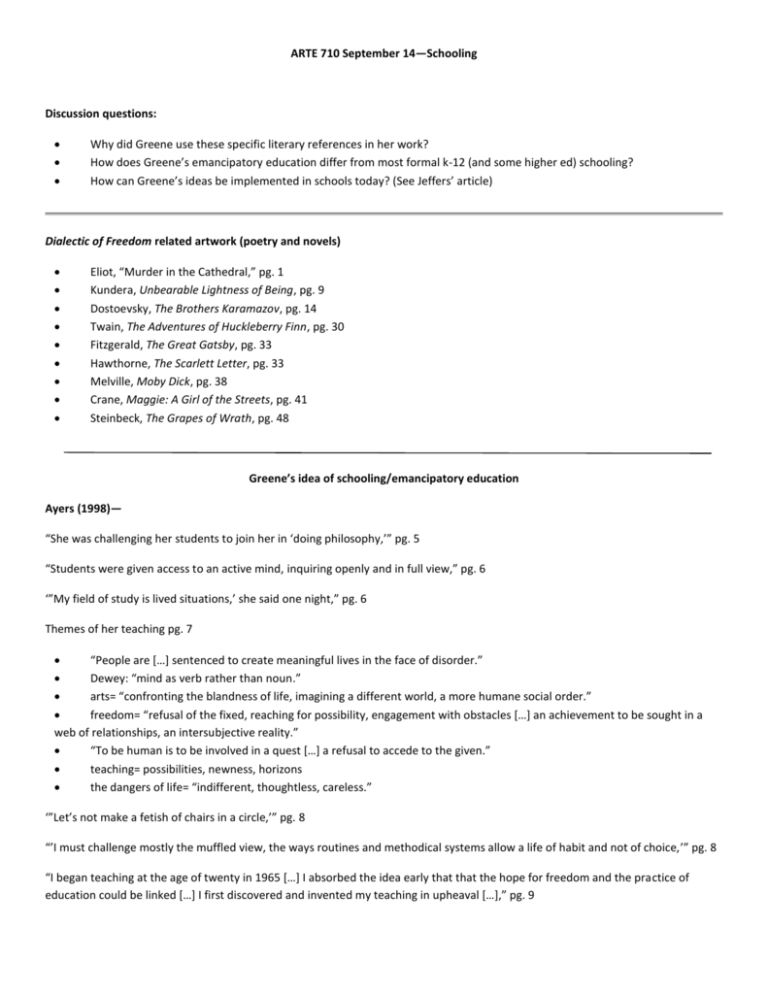
ARTE 710 September 14—Schooling Discussion questions: Why did Greene use these specific literary references in her work? How does Greene’s emancipatory education differ from most formal k-12 (and some higher ed) schooling? How can Greene’s ideas be implemented in schools today? (See Jeffers’ article) Dialectic of Freedom related artwork (poetry and novels) Eliot, “Murder in the Cathedral,” pg. 1 Kundera, Unbearable Lightness of Being, pg. 9 Dostoevsky, The Brothers Karamazov, pg. 14 Twain, The Adventures of Huckleberry Finn, pg. 30 Fitzgerald, The Great Gatsby, pg. 33 Hawthorne, The Scarlett Letter, pg. 33 Melville, Moby Dick, pg. 38 Crane, Maggie: A Girl of the Streets, pg. 41 Steinbeck, The Grapes of Wrath, pg. 48 Greene’s idea of schooling/emancipatory education Ayers (1998)— “She was challenging her students to join her in ‘doing philosophy,’” pg. 5 “Students were given access to an active mind, inquiring openly and in full view,” pg. 6 ‘”My field of study is lived situations,’ she said one night,” pg. 6 Themes of her teaching pg. 7 “People are […] sentenced to create meaningful lives in the face of disorder.” Dewey: “mind as verb rather than noun.” arts= “confronting the blandness of life, imagining a different world, a more humane social order.” freedom= “refusal of the fixed, reaching for possibility, engagement with obstacles […] an achievement to be sought in a web of relationships, an intersubjective reality.” “To be human is to be involved in a quest […] a refusal to accede to the given.” teaching= possibilities, newness, horizons the dangers of life= “indifferent, thoughtless, careless.” ‘”Let’s not make a fetish of chairs in a circle,’” pg. 8 “’I must challenge mostly the muffled view, the ways routines and methodical systems allow a life of habit and not of choice,’” pg. 8 “I began teaching at the age of twenty in 1965 […] I absorbed the idea early that that the hope for freedom and the practice of education could be linked […] I first discovered and invented my teaching in upheaval […],” pg. 9 Kohli (1998)— Greene’s personal philosophy =existential phenomenology (the study of lived experiences) and the idea of becoming pg. 11 Visual representations: tapestry and cyborgs pg. 12 Greene became involved in the philosophy of education was a “gendered accident;” Kohli introduces the background and historical context for Greene’s work and career pg. 13-16 “School” [?] needs to unite public and private pg. 16 “Philosophy as a noun is transformed into a verb in the Greene lexicon […] the philosophical act,” pg. 16 Greene (1988)— Rebuttal of the general definition of freedom, pg. 1 Humane choosing/intelligent choosing, pg. 4 We must believe that the world can be transformed, pg. 4 “Freedom ought to be conceived of as an achievement within the concreteness of lived social situations rather than as a primordial or original possession,” pg. 5 “Rather than being challenged to attend to the actualities of their lived lives, students are urged to attend to what is ‘given’ in the outside world,’” pg. 7 “There are ambiguities of various kinds, layers of determinateness. Freedom, like autonomy, is in many ways dependent on understanding these ambiguities,” pg. 9 About Hannah Arendt’s writing on WWII: “’[…] begun to create that public space between themselves where freedom could appear,” pg. 15 “Dewey […] did not believe that the self was ready-made or pre-existent; it was, he said, ‘something in continuous formation through choice of action’” pg. 21-22 “Becoming the ‘author’ of one’s world,” pg. 22 “Here and there, in the open space of a progressive private school, freedom was linked to spontaneity and expressiveness,” pg. 48 “We need to be continually empowered to choose ourselves, to create our identities within a plurality; we need continually to make new promises and to act in our freedom to fulfill them, something we can never do meaningfully alone,” pg. 51 “Freedom, as we have seen it, is the capacity to take initiatives, to begin,” pg. 55 NOT part of Greene’s view of schooling/emancipatory education (from Greene 1988) “The idea of freedom as an indulgence of the instinctual and the irrational,” pg. 7 Top of pg. 8: people as objects rather than subjects Pg. 12: schools seen as places to “process the young,” where “reality” is never questioned or criticized pg. 13: education as “kitsch,” and the school system as a “channeling colony” pg. 15: advocacy for a modern life that distracts from the search for freedom pg. 17: Who benefits from the current concept of American “freedom”? How does this negatively affect schooling? pg. 19: A shift from the public domain to an “intimate vision” (i.e., television, the internet) “Isolat[ion] from a world where people coming together might bring change,” pg. 25 “’scientific management’ and ‘efficiency’ in education,” pg. 48 “They said they felt obliterated as living persons, reduced to statistical formulations, to ‘IBM cards.’” U of Michigan students’ “sense of being manipulated by unknown forces, the powerlessness they had experienced under their apparent complacency,” pg. 51 “Schools could not and did not intend to ‘free’ children from automatism or ignorance so that they could become participating citizens and, at once, pursue success. Rather, the schools were meant to impose certain value systems and constraints so that energies would be appropriately channeled to suit the requirements of the society,” pg. 53 Bottom of pg. 54, dangers of technology Visual depiction of author’s POV: “Originally, I imagined a weaving. The sturdy warp, constituted by eh persistent themes of freedom, justice, community, democracy and imagination, meets the colorful woof threads spun out of the multiple realities from/to which she speaks […] On second thought, I realized this weaving might have to take the shape of a three-dimensional tapestry, a form open to improvisation, to complexity, to singularity” (Kohli, 1998, p. 12). (Image from Wikipedia, https://en.wikipedia.org/wiki/File:Tapestry_weaving.jpg) Schooling Annotated Bibliography Apple, M. W. (2008). Can schooling contribute to a more just society? Education, Citizenship, and Social Justice, 3 (3), 239-261. doi: 10.1177/1746197908095134 Apple’s article focused on the non-Greene style schooling that is typical in public schools after NCLB. He observed that it’s important for teachers to remember the localized context of their schools and the needs of their real children in their actual schools. Policies and required curriculum often do not match up with the realities of most classrooms (especially classrooms in less privileged areas). Apple warned that progressive/emancipatory educators need to keep their eyes open for neo-liberal school reforms that purport to bring freedom to education, but in reality are detached from the needs of students and the reality of students’ daily lives. Collin, R. (2011). Dress rehearsal: A Bourdieusian analysis of body work in career portfolio programs. British Journal of S Sociology of Education, 32(5). doi: 10.1080/01425692.2011.596378 Collin’s article offered a more specific example of a non-Greene style schooling initiative that, on the surface, sounds beneficial to students: a required program in high schools in which students prepare portfolios to “sell” themselves to employers and colleges. While the premise of the portfolio program states that students can use the portfolios to express themselves creatively and with a certain degree of freedom, in reality, only a strict type of portfolio is considered acceptable. Collin noted that students of higher social economic classes seemed more comfortable with this “limited freedom”/negative freedom than students from lower SES backgrounds. Eisner, E. W. (2003). Artistry in education. Scandinavian Journal of Educational Research, 47(3). doi: 0031383032000079317 In contrast to the first two articles, Eisner’s article advocated a view of schooling in line with Greene’s philosophy of schooling. Eisner claimed that artistry and creativity run parallel with education, and that formalized education should embrace the arts and eliminate policies that stifle student creativity. Jeffers, C.S. (1993). Teacher education: A context for art education. Journal of Aesthetic Education, 27(3). Retrieved from JSTOR.org. In this article about student teaching for art educators, Jeffers cited Philip Jackson’s work on the management of students in schools. Jackson wrote that the group, rather than the individual, is the focus in schools. This creates a challenge for encouraging the individual exploration of the arts and the sense of freedom that Greene discussed. Jeffers asked how art fits into the “managed” institution of schools, with a focus on teacher education. Sleeter, C. & Stillman, J. (2005). Standardizing knowledge in a multicultural society. Curriculum Inquiry, 35(1). Retrieved from JSTOR.org. The authors of this study used Basil Bernstein’s theory of “codes of power” to analyze standardized curriculum from California. They asserted that the state mandated curriculum, created mainly by educators of European-American backgrounds, isolated students of color, bilingual students, and others while building up the existing power of those already in control. Though this article did not address art education, it reflected the issues Greene discussed about schools not offering students the opportunity to “question reality.” Instead, the required California curriculum inflicted a view of reality on students that did not match up with their lived experiences.
